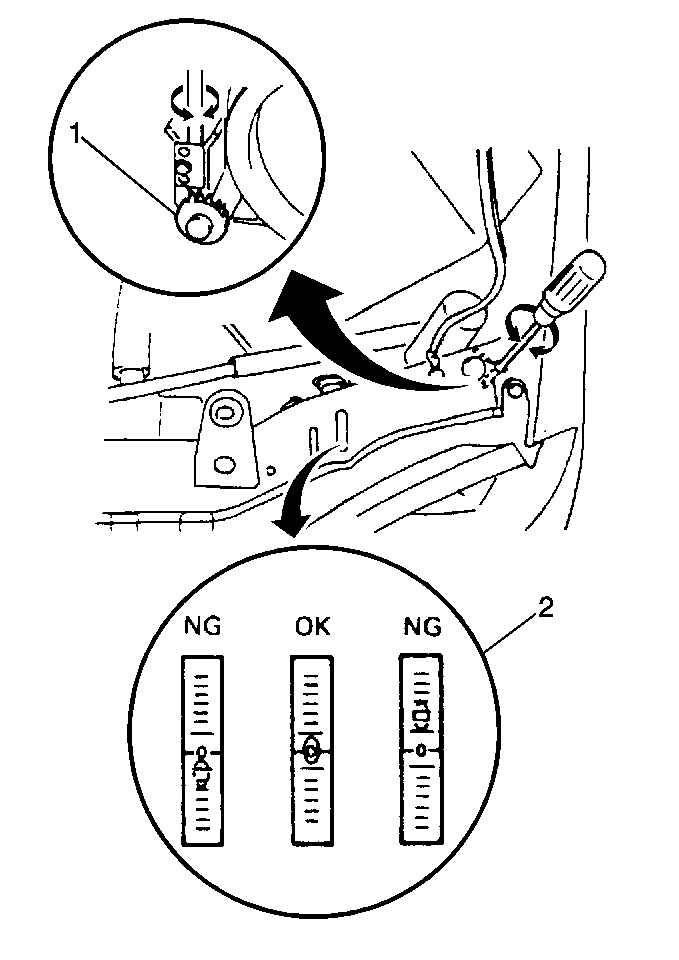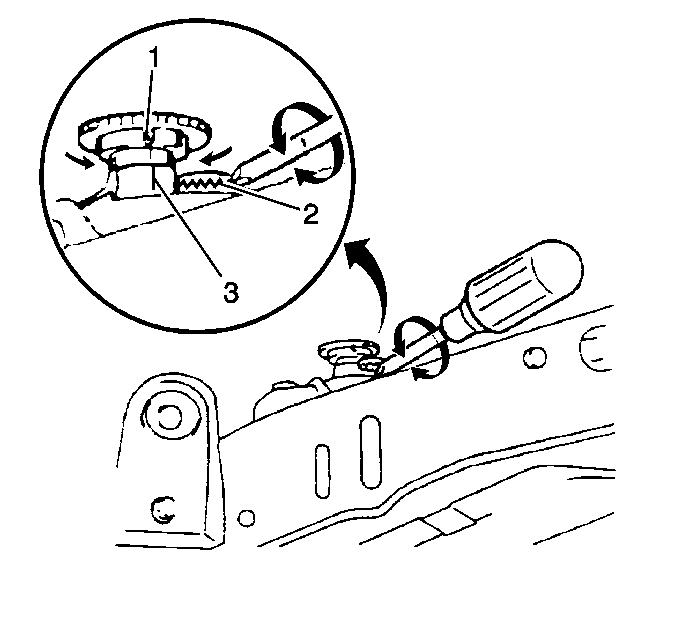Visual Aiming Procedure
All equipment for testing headlamps must comply with the SAE Recommended Practice for Headlamp Inspection Equipment.
If you use a headlamp testing machine, the machine should give results equivalent to the results obtained using the screen procedure.
The machine should be in good condition and be properly adjusted.
Use the machine in accordance with the manufacturer's instructions.
Machines that use a photoelectric cell or cells to determine aim, should also include a visual screen on which you can project a beam pattern proportional to the beam appearance, and aim on a screen at 7.62 m (25 ft).
| • | The screen should be plainly visible to the technician who is adjusting the headlamps. |
| • | The screen should have horizontal and vertical reference lines in order to permit visual evaluation of the headlamp beam. |
Headlamp Aiming Location (Using Screen Method)
The aiming area should be darkened and large enough to allow for the vehicle and an additional 7.62 m (25 ft), measured from the face of the headlamps to the front of the screen.
The floor on which the vehicle rests must be parallel with the bottom of the screen.
If the floor is not level, compensate accordingly.
Headlamp Aiming Screen
If you use a screen, the screen should be at least 1.52 m (5 ft) high x 3.66 m (12 ft) wide with a matte white finish, well shaded from extraneous light.
Properly adjust the screen to the floor on which the vehicle rests.
The screen should be moveable so that you can align the screen parallel to the rear axle of the vehicle.
Position the screen so that a horizontal line drawn perpendicular to the centerline of the screen will pass an equal distance midway between the two headlamps.
The screen should have the following items:
| • | A vertical centerline |
| • | Two laterally adjustable vertical tapes |
| • | One vertically adjustable horizontal tape |
If a regular commercial aiming screen is not available, the screen may consist of a wall having a clear, uninterrupted area at least 1.83 m (6 ft) x 3.66 m (12 ft) wide. The surface should be finished with a no-gloss white paint.
After the aiming screen has been set up and located, paint or tape a reference line on the floor 7.62 m (25 ft) from the screen. Park the vehicle with the front of the headlamps directly over this reference line.
Headlamp Aiming Procedure
Use the following procedure for aiming a headlamp.
- Park the vehicle square with the screen, with the headlamps directly over this reference line.
- Ensure that the components are in place if other work has been done on the vehicle.
- Ensure that the vehicle is on a level surface.
- Stop all other work on the vehicle.
- Ensure that the vehicle has half a tank, or less, of fuel.
- Close all of the doors.
- Rock the vehicle sideways.
- Line up the centerline of the vehicle with the centerline of the aiming screen.
- Adjust the vertical tapes on the screen in order to match the vertical centerline of each low beam headlamp.
- Adjust the horizontal tapes on the screen in order to match the horizontal centerline of each low beam headlamp.
- Turn on the low beam headlamps.
- Observe the left and the top edges of the high intensity zone on the screen.
- Adjust the headlamps to the following specifications:
| • | Mark the vertical center of the rear and front windows using tape. |
| • | Use these lines as sights in order to line up the centerline of the vehicle and the screen. |
Measure the distance from the centerline of the low beam lamp.
Measure the height from the floor to the center of the low beam.
| • | The top edge of the center of intensity on the screen for the low beam should be less than 101.6 mm (4 in) above or below the cross section of the headlamp centerlines. |
| • | The left edge of the center of intensity on the screen for the low beam should be less than 101.6 mm (4 in) to the left or right of the cross section of the headlamp centerlines. |
Alternate Headlamp Aiming Procedure
Properly aim the headlamps for maximum road illumination and safety. With halogen headlamps, proper aiming is very important. The increased range and power of these lamps make even the slightest variations from the recommended aiming hazardous to approaching motorists.
Observe the following conditions when you inspect or adjust the headlamp aim:
| • | The vehicle is on a level surface. |
| • | The tires are uniformly inflated to the specified pressure. See the tire placard located on the left side center pillar for the tire pressure specifications. |
| • | The vehicle has a full tank of fuel. One person or 150 lbs (68 kg) is on the driver's seat. |
| • | If the vehicle regularly carries an unusual load in the rear compartment or pulls a trailer, inspect the headlamps with these loading conditions. |
| • | Clean the headlamps before aiming. |
| • | Follow your state's requirements for headlamp aiming. |
A built-in Vehicle Headlamp Aiming Device (VHAD) equips each composite headlamp assembly.
- Open the hood.
- In order to adjust the vertical aim, turn the vertical aiming gear (1) until the bubble in the indicator is centered.
- In order to adjust the horizontal aiming gear the stopper must first be unlocked and the gear must not be engaged.
- Adjust the horizontal aiming gear (2) until the O-mark is in alignment with the center line.
- When the horizontal adjustments have been performed, lock and engage the horizontal gear with the stopper by pushing down on the stopper.


